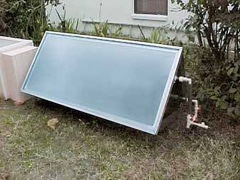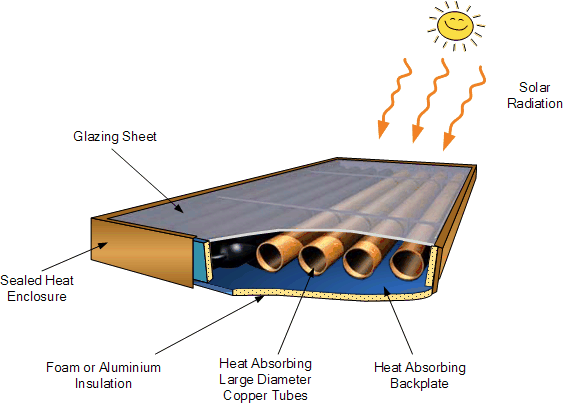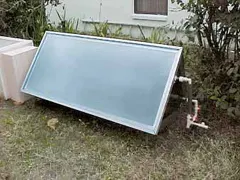
Integral Collector Storage
Integral Collector Storage Passive System
![]() The Integral Collector Storage systems, also known as ICS, “batch” or “bread box” water heating systems, are very similar in design and operation to the flat plate panel collector we looked at previously. This time however, the heat tubes inside the insulated glazed box are much, much bigger in diameter.
The Integral Collector Storage systems, also known as ICS, “batch” or “bread box” water heating systems, are very similar in design and operation to the flat plate panel collector we looked at previously. This time however, the heat tubes inside the insulated glazed box are much, much bigger in diameter.
As their name suggests, in an integral collector storage (ICS) system, the collector and tank are combined into one single unit so circulation pumps and electronic controls are not required as the household tap water is heated and stored within the combined heat storage and collection unit.
Integral collector storage units are one of the simplest solar hot water heating systems available and can be easily installed into any conventional water heating installation. ICS or “batch” systems, are made of a number of large diameter tubes of between 4 to 8 inches (100 – 200mm) in diameter with one or more black painted storage tanks included inside an insulated glazed weather tight box. Cold water flows under normal water pressure into the solar collector, which preheats and stores the water.
The transfer of the solar heat from the collector to the water is by natural convection, no outside energy is required making it a completely passive system. Whenever hot water is required, the solar heated water stored in the batch collector flows out buy the force of gravity or the pressure of the cold replacing it and continues into the conventional backup water heating system inside the house. This type of hot water installation is a direct system (open-loop) as the water being heated is the same water you drink.
ICS Construction

The main advantage of an “integral collector storage” system is that they do not need controls, pumps, sensors, or any other mechanical or moving parts, so maintenance requirements are minimal. Most of the ICS units produced today are “progressive tube type” heaters as opposed to the older single tank in a box type batch collectors making them less expensive than active solar systems.
ICS and batch collectors can be easily added to an existing domestic hot water installations. However, there are a number of disadvantages with batch collector systems such as weight, heat loss, efficiency and the possibility of freezing in cold weathers.
Integral collector storage or batch type systems put the tank and collector together to form a large mass of fluid to be heated by the sun. A major disadvantages of this type of solar hot water system is their weight. These systems are often mounted on the ground or attached to the side of buildings due to the weight of the collector. Roof mounted systems require a structure that is able to support the full weight of the storage tank(s).
One disadvantage of ICS batch systems is that they can lose their solar heat very quickly at night or during cloudy conditions when the suns energy is at its lowest. The result is that the storage collectors are good for those who use hot water at early at night, rather than first thing in the morning. An insulated cover placed over the collector at night can help retain heat in the storage tank but this can be impractical.
Also, because the collector is also a water storage device, some designs have double or triple glazing over the pipes or tanks to reduce heat loss but this adds to the overall weight and cost of the unit. Then “Integral Collector Storage” units are more inefficient in cold climates, due to heat losses at night.
Another disadvantages of integral collector storage devices is that they do not provide adequate freeze protection during the wintry months. ICS and batch systems must be drained during the freezing season or significant measures taken to prevent the water in the tank and associated plumbing from freezing.
Although the collectors and storage tank of ICS systems are freeze tolerant during normal operation they are climate limited meaning that warmer climates are the best suited for an ICS system and should be used only in warm and mild, sun-belt climates if draining of the system is not possible during the winter months.
While integral collector storage systems depend on system demand for their flow, some models have been configured to use the thermosyphon principle. The thermosyphon ICS system uses the principle of natural convection of fluid between a collector and an elevated storage tank. As water is heated in the collector and it rises naturally to the tank above.
Thermosyphon systems tend to be more efficient than standard ICS and batch systems. As the thermosyphon ICS system is connected directly to the mains water supply it is difficult to protect from freezing. However, new closed-loop models are coming onto the market that use a non-freezable fluid as the heat transfer fluid, solving the freezing problem.
ICS Summary
Then to summarise, Integral Collector Storage (ICS) systems, also called a “batch” or “breadbox” water heater, combine a solar collector and water storage tank into one single unit.

Solar batch water heaters are the most common home-made solar hot water heating device as they can be easily constructed using large diameter copper, plastic tubing or an old copper water cylinder inside a wooden box, in fact batch collectors are known affectionately as a “tank in the sun”.
The sun’s rays shining on the collector strikes the large diameter tubes or storage tank directly, heating the water. The water’s large thermal mass along with the insulation helps reduce heat loss through the tank at night.
Although lower in efficiency, performance and hot water temperature than other types of solar hot water heating systems, the advantages of ICS units are their inherent simplicity, low cost, easy installation making them a good project for the DIY’er. As collector storage systems are passive systems, they do not require electrical pumps or electronic controllers thereby eliminating reliability and maintenance problems make these systems an attractive alternative to the more complicated and expensive solar thermal systems.
However, the main disadvantage of integral collector storage and batch systems is that these types of solar heating systems are only appropriate for mild and warmer climates which prevents the stored water from freezing in winter. A number of steps can be taken to combat freezing in the winter and heat loss at night such as draining of the system, covering the collector glazing at night or protecting it within a secondary transparent solar box.
Even if an ICS or batch system is drained for winter and is only used for the six or seven months summer period, it can still have a significant impact on annual energy costs, especially since the installation costs for these systems can be much lower than those of other solar water heater types.
In our next tutorial about Solar Heating, we will look at how we can make the most of the suns free solar energy by heating water more efficiently to very high temperatures using solar reflectors in the form of a Parabolic Trough Reflector which can be used to focus the sun’s energy onto a single point.










I like the design on this one, it looks very efficient!
Due to its perfect combination of a solar collector with a hot water storage tank, SolPal® is more efficient than traditional thermosiphon systems.